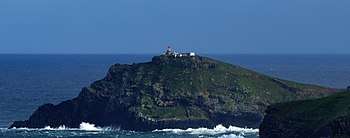Ilhéu do Farol
 Ilhéu do Farol and its buildings with its magnificent lighthouse | |
 Location of the islet inside the Island of Madeira | |
| Geography | |
|---|---|
| Location | Atlantic Ocean |
| Coordinates | 32°43′0″N 16°39′0″W / 32.71667°N 16.65000°WCoordinates: 32°43′0″N 16°39′0″W / 32.71667°N 16.65000°W |
| Total islands | 1 |
| Highest elevation | 93 m (305 ft) |
| Concelhos (Municipalities) | Machico Municipality |
| Demographics | |
| Population | 0 |
Ilhéu do Farol is an uninhabited islet located east of the easternmost point of the Madeira Island in the eastern Madeira. It is also located east of the town of Caniçal and forms a part of the municipality of Machico. The islet is adjacent to Ilhéu da Cevada, a slightly larger islet to the west. Both are part of the Ponta de São Lourenço natural reserve. Northeast of the islet is Porto Santo and southeast are the Desertas Islands.
About the islet
The islet's highest point is at 93 m. The islet only consists of shrubs and herbaceous vegetation.[1] The north side is a coastal cliff.
The island is most notable for its lighthouses which gives the islet the name. The island and the islet has no land animals but has numerous birds and was in the area that the nesting of the gull Sterna dougalli was recorded in Madeira. It also nests the chick Puffinus assimilis. Along with all of the islets in the area, it forms a part of Madeira Natural Park and Ponta de São Lourenço Partial Reserve.
A few kiliometers east has waters deeper than 100 metres and around 5-10 km north and east is more than 1,000 metres.
During the Ice Age around 10,000 years ago, along with all of the surrounding islets, it was part of the larger island of Madeira It separated between 5000 to 3000 BC when the sea level was risen nearly to its current level.
Some knowledge of Atlantic islands, such as Madeira, existed before the discovery and settlement of these lands in 1418. The islet was never understood until its recorded discovery when Madeira along with the islet were accidentally discovered after captains were storm blown into its sheltered harbor. They were in the service of Infante Henrique of Portugal. João Gonçalves Zarco and Tristão Vaz Teixeira had been ordered by King John I to discover new territory west of Africa and had been sent off-course by a storm while making the volta do mar westward swing return voyage. The islet has never been inhabited.